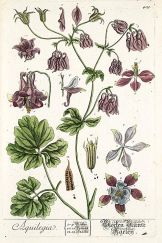Columbine:
The Mourning Dove
By Audrey Stallsmith

He looked again. . .through the shadowy pine trees as through a doorway, at the green-grassed garden-path rising from the shadow of alders by the log bridge up to the sunlit flowers. Tall white and purple columbines. . .
D. H. Lawrence, England my England
Due to the tragedy which occurred at a high school bearing its name, the state flower of Colorado is now associated with violence and death. But, ironically enough, columbine derives from columba, the Latin word for dove.
The dove, as we all know, has long been a symbol of peace, gentleness, and love. That reputation apparently transferred to the flower, with Francis Bacon referring to "columbine innocency." In European pantomime, Columbine was Harlequin's dancing sweetheart, and the Italian columbina a term of affection.
In the past, columbine was also known as culver, culverwort, or culverkey after culfre, the Saxon word for pigeon. In this country, the flower's common names include meetinghouses, rock bells, wild honeysuckle, and Granny's bonnets. Only in its Latin title, aquilegia, which derives from aquila-- "an eagle," does columbine show a fiercer side.
The plant's long association with birds has several possible explanations. Some think the flower's circle of spurs resembles doves perched around a fountain. Others contend that those spurs look like eagle talons. But all must agree that columbine blooms, poised quiveringly atop springy stems, seem ever on the verge of taking flight.
Despite its gracefully frail appearance, aquilegia is a tough plant. The Virginian refers affectionately to wild white columbines growing among the mountain pines. Although some varieties will flourish in sun, most prefer to withdraw shyly into partial shade and a light, humus-y soil which won't hold them down. The plant's chief enemy is the leaf miner, a tiny worm which mars the lovely blue-ish foliage with winding trails.
Perhaps its appearance of insubstantiality is what caused the columbine to stand for "folly" in the Language of Flowers. A purple variety declares the giver to be "resolved to win," while a red type indicates that he/she is "anxious and trembling."
The Indians used wild columbine to relieve heart troubles and fevers, as a sedative, and as a wash for poison ivy. Braves rubbed the ground seeds into their hands as a love potion and perfume.
Europeans treated sore throats with the leaves and kidney stones with the roots. A mixture of six herbs, including columbine, was reputed to destroy the pestilence "be it never so fell." Since children were sometimes accidentally poisoned by the plant, however, it is probably too dangerous for modern use as an herb.
It does make an excellent ornamental for the semi-shaded flower garden, though, being available in a wide variety of exquisite shapes and sizes. The gardener can choose from single, double, pleated, alpine, clematis-flowered, and anemone-flowered types, among others.
This May-blooming plant will now always stand as an apt symbol for the lives which "flew away" in the freshness of their youth. Years ago, C. W. McCall could almost have been forseeing the tragedy when he sang of the wild Rockies' variety, "Columbine, columbine, blue on the mountain,"--and added plaintively, "Will you miss me when I've gone away?"
Aquilegia image is from Herbarium Blackwellianum by Elizabeth Blackwell, courtesy of the Missouri Botanical Garden.








